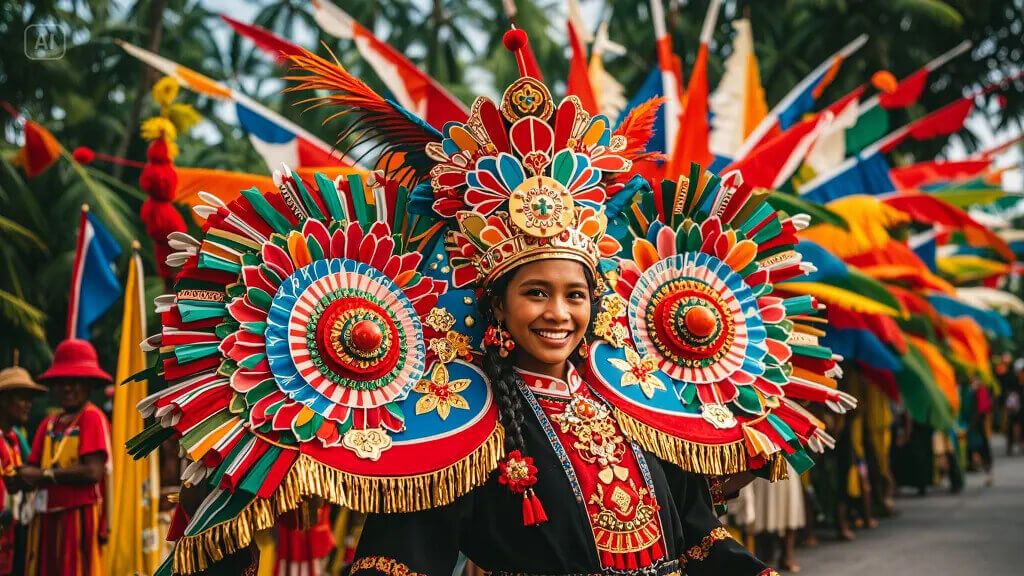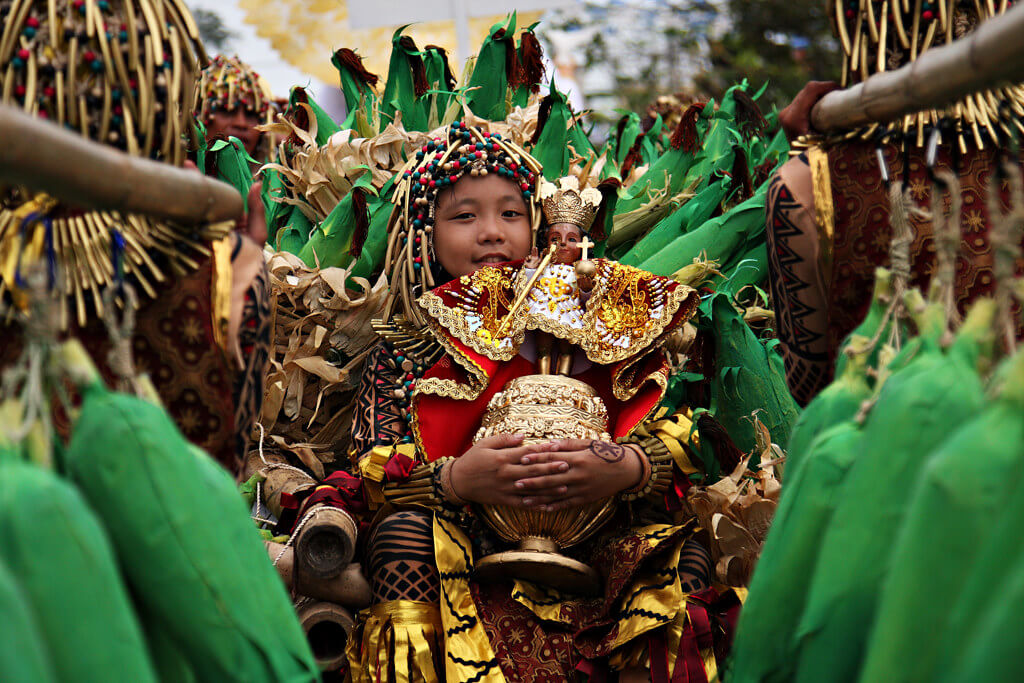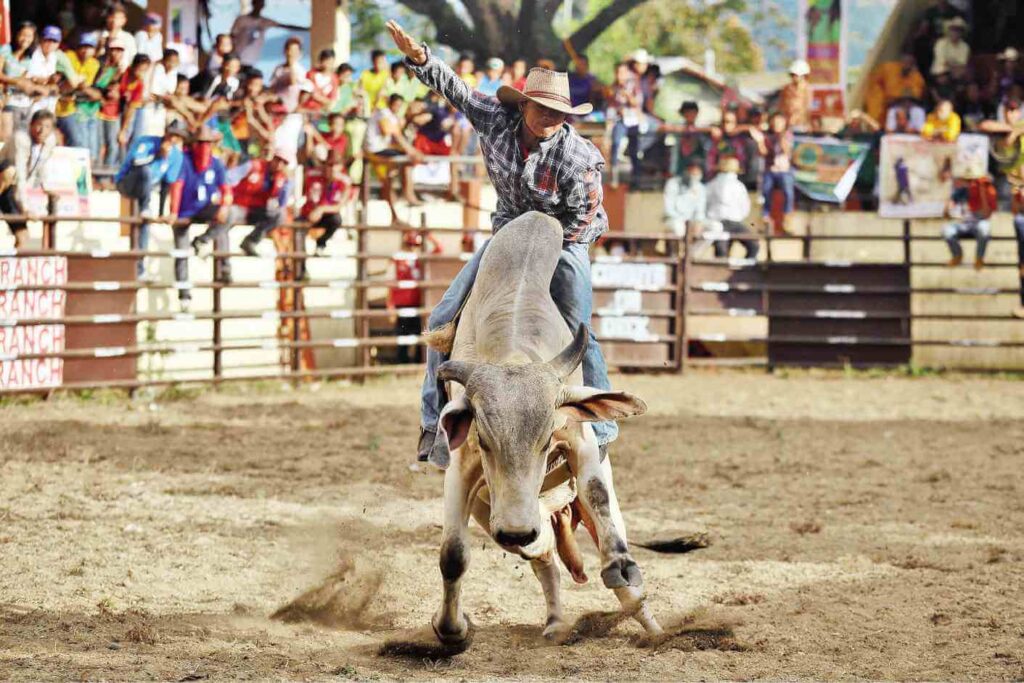The Vibrant Ati-Atihan Festival
Tradition and Modernity
The Ati-Atihan Festival, held in Kalibo, Aklan, is renowned for its splendid blend of ancient customs and contemporary celebrations. The festival showcases intricate traditional costumes that merge cultural heritage with modern flair (Pinas Culture). These vibrant attires often incorporate feathers, beads, and colorful fabrics, symbolizing the rich history and traditions of the indigenous people. The detailed designs of these costumes embody the enduring connection between past and present, fostering a sense of devotion and pride among the participants.
| Costume Element | Symbolism |
|---|---|
| Feathers | Freedom and Strength |
| Beads | Unity and Spirituality |
| Colorful Fabrics | Heritage and Identity |
The fusion of tradition and modernity at the Ati-Atihan Festival is evident in every aspect of the festivities. Not only do the participants wear attire that reflects their ancestors’ legacy, but they also embrace contemporary fashion trends, creating a unique and inclusive cultural experience. This harmonious blend of the old and new makes the festival a dynamic and evolving celebration of Filipino creativity and resilience. For more on the vibrant costume designs, visit our article on ati-atihan festival costumes.
Unity Through Festivities
One of the most remarkable aspects of the Ati-Atihan Festival is its ability to unite people from all walks of life. Each year, thousands of locals and tourists alike gather to partake in the festivities, highlighting the profound sense of solidarity within the community (Pinas Culture).
The festival serves as a testament to Filipino resilience, offering a platform for individuals to come together in celebration of their shared heritage. Participants engage in various activities designed to foster camaraderie and community spirit, from vibrant parades to spirited musical performances, creating an atmosphere of joy and harmony.
| Activity | Participants | Description |
|---|---|---|
| Parades | Locals and Tourists | Colorful marches showcasing intricate costumes |
| Musical Performances | Local Bands and Performers | Rhythmic tunes that energize the crowd |
| Dance Competitions | Dance Groups | Enthusiastic displays of traditional and contemporary dances |

Photo by Festive Pinoy
The vibrant displays of culture and the joyous communal gatherings exemplify the spirit of unity that characterizes the Ati-Atihan Festival. By celebrating together, individuals strengthen their connections and build lasting bonds. For more information on the festival’s rich history, check out our article on ati-atihan festival history.
The Ati-Atihan Festival is not only a celebration of cultural heritage but also a powerful symbol of unity and togetherness that transcends generations. These festivities bring people closer, nurturing a collective identity rooted in tradition and shared experiences. Interested in the rhythmic beats that define the event? Learn more about the ati-atihan festival music that adds a unique flavor to this cultural extravaganza.
Culinary Delights at Ati-Atihan
The Ati-Atihan Festival is not only known for its vibrant festivities but also for its rich culinary offerings. Visitors can immerse themselves in a wide array of traditional and modern dishes that highlight the region’s diverse flavors and cultural heritage.
Cultural Fusion of Flavors
One of the standout features of the Ati-Atihan Festival is the fusion of indigenous flavors and Spanish influences in its culinary delights. This blend creates a unique gastronomic experience that celebrates the rich history and diversity of the Philippines.
Traditional Dishes
During the Ati-Atihan festivities, you’ll find a variety of traditional dishes that reflect the cultural roots of the region. Some of the must-try dishes include:
- Savory Grilled Seafood: Freshly caught seafood grilled to perfection, often seasoned with local spices.
- Coconut-Based Dishes: Aromatic dishes prepared with coconut milk, highlighting the abundant coconut supply in the region.
| Traditional Dish | Description |
|---|---|
| Grilled Seafood | A selection of fish, shellfish, and other seafood, grilled and seasoned with native spices. |
| Coconut Curry | A rich and flavorful curry made with coconut milk and a blend of local herbs and spices. |
Modern Dishes
The festival also showcases modern dishes that incorporate contemporary culinary trends while maintaining a connection to traditional flavors. This fusion of old and new provides a fresh and exciting dining experience.
- Filipino Paella: A local take on the Spanish classic, combining seafood, chicken, and rice infused with Filipino flavors.
- Fusion Desserts: Modern twists on traditional Filipino desserts, such as coconut-flavored crepes and mango tarts.
| Modern Dish | Description |
|---|---|
| Filipino Paella | A dish that blends the classic Spanish paella with ingredients native to the Philippines. |
| Mango Tart | A dessert featuring ripe Philippine mangoes in a crisp tart shell. |
For more on the fascinating history of the Ati-Atihan Festival, make sure to visit our section on ati-atihan festival history.
Street Food Extravaganza
The streets of Kalibo come alive with various food stalls and vendors during the Ati-Atihan Festival. This bustling food scene presents an opportunity to sample quick bites and snacks that are integral to the local culture.
- Banana Cue: Fried bananas coated in caramelized sugar, skewered and served hot.
- Isaw: Grilled chicken intestines, a popular Filipino street food delicacy.
Attending the festival allows food enthusiasts to experience the true essence of Filipino culinary arts. The fusion of flavors and the variety of dishes available ensure that there’s something to satisfy every palate. For more insights on the music that accompanies these feasts, check out our article on ati-atihan festival music.
Artisan Crafts and Souvenirs
Festivals in the Philippines are incomplete without the intricate artisan crafts and souvenirs that reflect the rich cultural heritage of the region. The Ati-Atihan Festival is no exception and offers a treasure trove of handcrafted items that visitors can take home as keepsakes.
Cultural Heritage in Handcrafts
The Ati-Atihan Festival showcases a variety of handcrafted souvenirs made by indigenous artisans. These crafts are a testament to the region’s cultural heritage and creativity. Visitors have the opportunity to purchase a range of unique items, such as masks of ancient deities and textiles depicting local myths (Pinas Culture). These items are not only mementos but also symbols of the deep-rooted traditions and artistry of the locals.
Types of Souvenirs:
- Masks: Often representing ancient deities, these masks are intricately designed and painted, embodying the spirit and history of the festival.
- Textiles: Featuring traditional weaves and prints, these textiles tell stories of local myths and legends.
- Jewelry: Handcrafted jewelry pieces made from indigenous materials are another popular souvenir.
- Woodcrafts: Custom-made sculptures and other woodcraft items are often sold at the festival.
| Souvenir Type | Description | Approximate Price (PHP) |
|---|---|---|
| Masks | Handcrafted, painted masks of ancient deities | 500 – 1500 |
| Textiles | Traditional weaves and prints | 300 – 1000 |
| Jewelry | Indigenous materials, handcrafted designs | 200 – 800 |
| Woodcrafts | Custom-made sculptures and items | 400 – 2000 |
These artisan crafts, available throughout the festival, are made using traditional methods passed down through generations. By purchasing these items, visitors not only get to bring a piece of the festival home but also support the local artisans and their crafts.
For those interested in the festival’s vibrant attire, more details can be found on our page about ati-atihan festival costumes.
Embracing the art and culture of the Ati-Atihan Festival through its crafts and souvenirs offers a deeper connection to the history and traditions of the Philippines. For more information about the festival and its various activities, such as the rhythmic musical celebrations, check out our article on ati-atihan festival music.
Musical Celebrations
The heart of the Ati-Atihan Festival lies in its vibrant and dynamic musical celebrations. Music plays a pivotal role in unifying the community and creating an atmosphere of joy and togetherness.
Rhythms of Ati-Atihan
The Ati-Atihan Festival is renowned for its rhythmic and energetic music, which is deeply rooted in tradition. Traditional instruments like the Ati-Atihan Drums, Tambol, Agung, Kudyapi, and Maracas enhance the cultural ambiance with their harmonious sounds (Pinas Culture). These instruments come together to create the festival’s unique and lively musical landscape.
The formal opening mass of the Ati-Atihan Festival is accompanied by rhythmic beats from bass drums, metal clinking, and stone-on-bottle sounds, elevating the vibrancy of the celebration (MyBoracayGuide).
Over 80 music groups perform upbeat Filipino tunes throughout the festival, fostering a joyous and lively ambiance. These performances include a variety of musical styles, each contributing to the festival’s dynamic atmosphere. The music groups are highly spirited, and their energetic performances encourage festival-goers to dance and join in the celebrations.
The street parade, known as Sadsad, is a central part of the Ati-Atihan Festival’s activities. Participants drag their feet along the ground in tune with the marching band’s beat, creating a unique and engaging dance style (Wikipedia).
Here’s a look at the prominent musical elements present during the festival:
| Element | Description |
|---|---|
| Ati-Atihan Drums | Traditional drums that set the rhythmic foundation of the festival’s music. |
| Tambol | A type of drum that adds depth and resonance to the musical ensemble. |
| Agung | A large, heavy, and horizontally suspended gong that is struck with a mallet, providing a resonant bass tone. |
| Kudyapi | A native stringed instrument that adds melodic and harmonic textures to the music. |
| Maracas | Hand-held percussion instruments that add a distinctive, rattling sound to the musical mix. |
To experience the mesmerizing beats and melodies in person, you can explore our detailed guides on ati-atihan festival music and ati-atihan festival dance.
The rhythmic beats and lively tunes at Ati-Atihan Festival are not just music to the ears but a call to embrace the culture, to dance, and to celebrate the essence of unity and joy.
Share this post: on Twitter on Facebook



